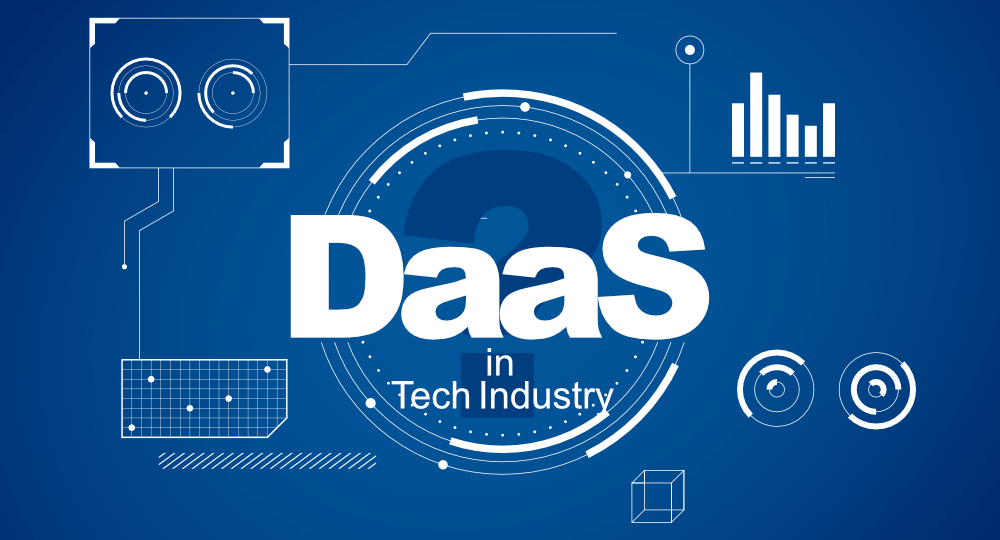That’s where Data as a Service(DaaS) comes in! It allows companies to obtain the data they need and also improve their data analytics, reduce the time to obtain data insights, and increase the reliability of their data. But what is this “Data as a Service”? Let’s attempt to answer this question first before moving on to its pricing models, advantages, and disadvantages.
What is Data as a Service?
Data as a Service(DaaS) is becoming a popular concept with the advent of cloud-based services. DaaS is provided by data vendors that use cloud computing to provide data storage, data processing, data integration, and data analytics services to companies using a network connection. Hence, Data as a Service can be used by companies to better understand their target audience using data, automate some of their production, create better products according to market demand, etc. All of these things in return increase the profitability of a company which in turn gives them an edge over their competitors.
Data as a Service is similar to Software as a service, Infrastructure as a service, Platform as a service, etc. which are all common services that everyone has heard of in the tech world. However, DaaS is comparatively new and gaining popularity only now. This is partly because basic cloud computing services provided by companies were not equipped initially to handle the massive data loads that are a necessary part of DaaS. Instead, these services could only manage basic data storage rather than data processing and analytics on such a large scale. Also, it was difficult to manage large data volumes over the network earlier as the bandwidth was limited. However, these things have changed with time and now, low-cost cloud storage and increased bandwidth have made Data as a Service the next big thing!
It is estimated that DaaS will be used by around 90% of large companies to generate revenue from data by 2020. Data as a Service will also allow different departments in large companies to share data easily with each other and obtain actionable insights even if they don’t have the data infrastructure in-house to manage this feat. Therefore, DaaS will make sharing data for companies much easier and faster in real-time, which will, in turn, increase the profitability of a company.
Pricing models for Data as a Service
Companies that provide Data as a Service also set up pricing models based on the data access required by their customers. These pricing models are usually divided into two ways, volume-based models and data type based models. Let’s check them out in more detail:
1. Volume Based Models
In the volume-based models, data vendors charge their customers based on the volume of data. These models are further divided into quantity-based pricing and pay-per-call services. For quantity-based pricing, the data vendors charge based on the quantity of data a company wants to use. While this is the easiest pricing method, it fails to handle the situation when the value of the data exceeds its pricing. The data vendors can also use the”fire-hose” approach, in which they offer an unlimited quantity of data to companies for a certain price. Apart from quantity-based pricing, data vendors can also use pay-per-call services. These are best when companies require a lesser quantity of data and the data vendors simply charge for each call to the API by the company.
2. Data Type Based Models
In the data type based models, data vendors charge their customers based on the type of data they require rather than the volume of data they use. Hence, the data is priced according to its attributes and more complex or detailed data may be pricier. Some examples of the types of data can be geographical data, historical data, medical data, financial data, etc. But broadly speaking, it is better for data vendors if they combine the volume-based and data type based pricing models and charge based on the amount and type of data. This will ensure that both the vendors and their customer companies obtain the most benefit from Data as a Service.
What are the advantages of Data as a Service?
1. Minimal Setup Time
Data as a Service requires minimal setup time as companies can immediately start storing and processing the data from the data vendors. Companies are also accessing the data from a third-party vendor which means the data is already organized and ready for use. So companies do not need to spend so much time in data collection and cleaning as they would if they collected the data from scratch This is especially useful for those companies that don’t have data analytics and machine learning as their core business but just want to leverage data to enable better decision making in their domain.
2. Cost Savings
Implementing Data Management from scratch is expensive but this expense is reduced by using Data as a Service. Most DaaS vendors have specific subscription plans for companies that can be bought at a fixed price based on the volume or type of data. This means that a company does not need to finance increasingly complex data collection mechanisms but they can buy what they want and pay just for that. Companies can also decide the resources they want to allocate to the data and increase or decrease them as required.
3. Ease of Usage
It is comparatively easy for companies to implement Data as a Service rather than collect, clean, and analyze data from scratch. Most companies that offer DaaS have pre-created packages of different data services based on the type or volume of data that other companies can buy. Companies can also access the data easily because the data architecture for the DaaS is quite simplistic. In addition to that, if the company needs to change its data requirements or shift the data geographically or perform any other data modifications, they are relatively easy to implement.
4. Options for Scalability
Data as a Service is more scalable than an individual company based data system since companies can decide how many resources to allocate to the data analysis and increase or decrease them. Companies can start with smaller projects using DaaS just to see if the data is useful. And later, when companies are more confident about their projects and more knowledgeable with their data, they can always scale up their projects as the corporate demands change over time.
What are the disadvantages of Data as a Service?
1. Reduced Security
Data vendors need to share their data with the companies that required the Data as a Service. However, this makes the data vulnerable as it has to be moved from the cloud infrastructure and into local storage over the network. The data is not that secure as it would have been if it were just stored in the local storage behind firewalls and not moved. And so companies need to provide extra security measures for data storage and data transit between different servers to ensure that the data isn’t stolen, shared improperly, or tampered with.
2. Increasing reliance on Third-Parties
Data as a Service by default implies that companies are reliant on their service vendors to provide them with the data they need for data analysis according to their company requirements. While this is not a bad thing as companies are gaining a lot of benefits and insights with a minimum investment in DaS, it does mean that companies can suffer if there are miscommunications or errors in the data or any other problems between them and their service providers.
3. Limited Capabilities
Data vendors provide data to companies based on financial gains and the type of data that companies require. However, they may limit the tools that companies can use to extract meaning from the data. DaaS providers make sure that companies are only able to use the tools provided by them on the data and not their tools or individual data analytics solutions. However, if companies collect their data, then they are free to analyze it however they want to obtain actionable insights. So companies should ensure that they use DaaS only when the benefits outweigh the costs of developing their data collection and analysis systems.
4. Increased Data Transfer Timings
Data as a Service involves transferring large amounts of data from the data vendors to customer companies. However, this can take a lot of time due to bandwidth limitations. This can create serious time issues for companies that need to frequently transfer data to and from the DaaS cloud infrastructure and into local company storage. In such situations, data compression and edge computing can be used to increase the data transfer speeds and reduce the time required.





